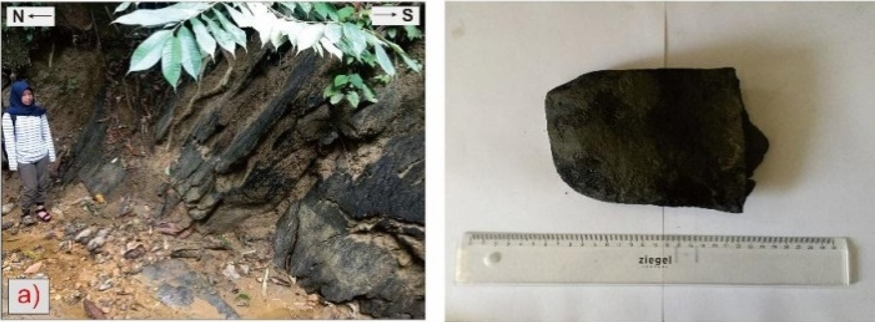Middle Miocene Black Shale of Airbenakat Formation in Berau Areas, Jambi: are they potential source rock?
DOI:
https://doi.org/10.25299/jgeet.2019.4.2.1774Keywords:
Source Rock, Shale, Air Benakat FormationAbstract
The research location is geologically located in Jambi Sub-basin composed by Peneta Formation (KJp), Airbenakat (Tma), and Muara Enim (Tmpm). Specifically this research focuses on the physical characteristics and geochemistry of Middle Miocene black shale from Airbenakat Formation. The purpose of this research is to determine whether the black shale of this formation has the potential as a source rock. The method of this research are field observation that includes the description of rock samples and geological mapping, and laboratory analysis including rock geochemical analysis. Three samples were taken from black and fine-grained shale. Total organic carbon (TOC) values of the three samples taken ranged from 0.38-0.42%, the weight of TOC indicates a potentially close enough to produce hydrocarbons. the pyrolysis results show that the S1 data gives a value below 0.5 HC/g and S2 gives a value below 2.5 HC/g, so it can be seen that the three rock samples that tested are not sufficient enough to produce hydrocarbons. Overall the sample has a S2/S3 ratio ranging from 0.09-0.23 and Tmax-HI data has values ranging from 8-19 mg HC/g TOC, so it can be seen that the ratio S2/S3 less than 1 and the value of the index hydrogen below 50 mg HC/g TOC, It can be concluded that the samples are derived from type IV kerogen. The maximum temperature (Tmax) of pyrolysis shows a value of less than 4350C, where the values range from 350-4280C. So, it can be interpreted that the three samples are immature source rocks because the catagenesis phase to produce hydrocarbons has not been achieved. The conclusions is the three samples of black shale tested indicate potential as immature source rock and has the close enough ability to produce hydrocarbons. The result of the analysis then comparable with the result analysis of Airbenakat Formation Black Shale in Palembang Sub-basin which has fair-well ability to produce hydrocarbons.
Downloads
References
Clayton, C., 2005. Petroleum Generation and Migration. Nautilus, Ltd.
Ginger, D., and Fielding, K., 2005. The Petroleum System and Future Potential of the South Sumatra Basin. Proceeding 30th Annual Convention and Exhibition, Indonesian Petroleum Association., 2005.
McCarty, K., Rojas, K., Niemann, M., Palmowsky, D., Peters, K., and Stankiewicz, A., 2011, Oilfiel review Summer: 23/2, Schlumberger.
Peters, K. E., 1986, Guidelines for Evaluating Petroleum Source Rock Using Programmed Pyrolysis, The American Association of Petroleum Geologists Bulletin, No. 3, Vol. 70, p. 318-329.
Peters, K.E and Cassa, M.R., 1994, Applied Source Rock Geochemistry in The Petroleum System From Source to Trap, USA: AAPG Memoir.
Pulunggono, A., Haryo, A. and Kosuma, C.G., 1992. Pre- Tertiary and Tertiary Fault systems as a framework of the South Sumatera Basin; A Study of SAR-MAPS. In Proceedings Indonesian Petroleum Association 21th Annual Convention.
Spruyt, J.N., 1956. Subdvisions and Nomenclature of The Tertiary Sediments of The Jambi-Palembang Area. Pertamina Internal Report.
Waples, D., 1985. Geochemistry in Petroleum Exploration. Boston, s.n.

Downloads
Published
Issue
Section
License
Copyright @2019. This is an open-access article distributed under the terms of the Creative Commons Attribution-ShareAlike 4.0 International License which permits unrestricted use, distribution, and reproduction in any medium. Copyrights of all materials published in JGEET are freely available without charge to users or / institution. Users are allowed to read, download, copy, distribute, search, or link to full-text articles in this journal without asking by giving appropriate credit, provide a link to the license, and indicate if changes were made. All of the remix, transform, or build upon the material must distribute the contributions under the same license as the original.










